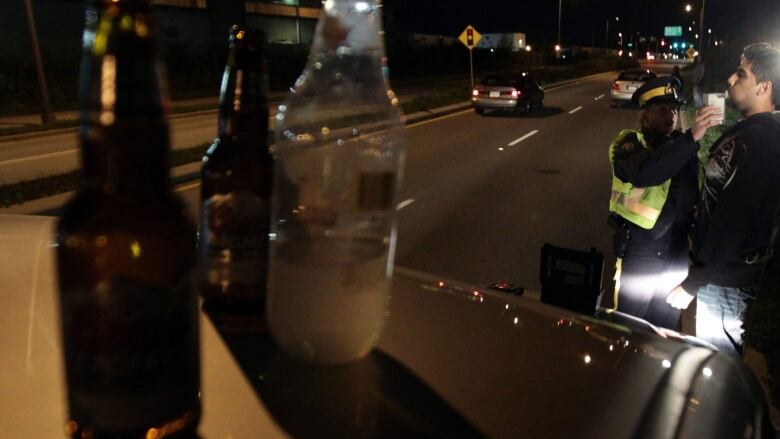Impaired driving can be from drugs or booze, police warn
Police with drug recognition training can check for signs of impairment

Police agencies are once again reminding people about the dangers of drinking and driving as well as the effect that drugs even prescription medicines can have on drivers.
One study, of 14,000 driver fatalities, found 33 per cent of drivers tested positive for at least one drug and 38 per cent tested positive for alcohol.
The most common drugs are depressants, stimulants and marijuana.
While police have a number of field tests to check suspected drunk drivers, checking for impairment by drugs is a different matter.
Officers who are Drug Recognition Evaluators have extra training to spot drug-related impairment, but not all police have that designation.
"Some of our methods have changed in order to deal with people who have been impaired by drugs," RCMP Cpl. Allana Graham told CBC News Friday. "There are more courses available to members to deal with people who are impaired by drugs."
The details of how an officer evaluates a person for drug use were outlined in a recent provincial court decision by a judge in Melfort.
Among the tests the officer used were:
- Moving a pen in front of the subject, who must follow the movements without moving his head.
- A modified balance test where the subject stands with his eyes closed and tilts his head back. The subject is asked to estimate, without counting aloud, 30 seconds going by and then bring his head forward. (A subject who moves forward after an actual time of 25 to 35 seconds is considered normal.)
- A walk and turn test, where the subject is told to walkheel-to-toe along a line on the floor for nine steps, turn and walk nine steps. The subject must keep his arms at his sides during the test.
- A one-legged stand test, where the subject puts his arms at his side and raises a foot six inches off the ground. The person counts out the 30 seconds. The test starts with the person standing on their left leg and then their right. Placing a foot down during the test, raising the arms or losing balance counts against a scoring system.
- The finger to nose test, where the subject stands with his eyes closed, tilts his head and and is told to touch the tip of his finger to the tip of his nose and immediately put his hand down. The test is scored based on how well the instructions are followed. (Some subjects miss their nose, or forget to put their hand back down.)
In the Melfort case, the officer concluded his subject was likely impaired and demanded a urine sample.
The judge convicted the man based upon the results of the urine testing.
While the Melfort case led to a conviction in another Saskatchewan case, involving an allegation of marijuana use leading to impairment, a judge was not so convinced of the evidence provided and the accused was found not guilty.
Reporters in Regina were also shown how driving is affected due to impairment. A special driving simulator was used to illustrate the point.












_(720p).jpg)


 OFFICIAL HD MUSIC VIDEO.jpg)
.jpg)



























































































